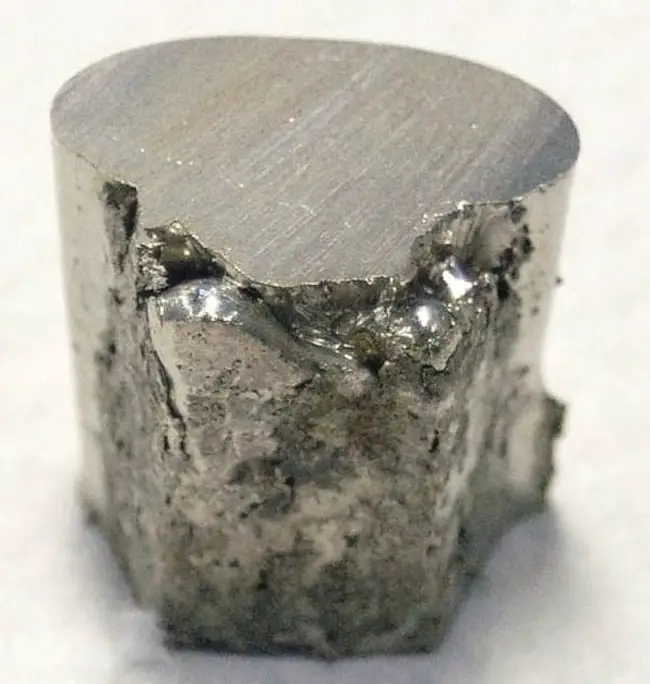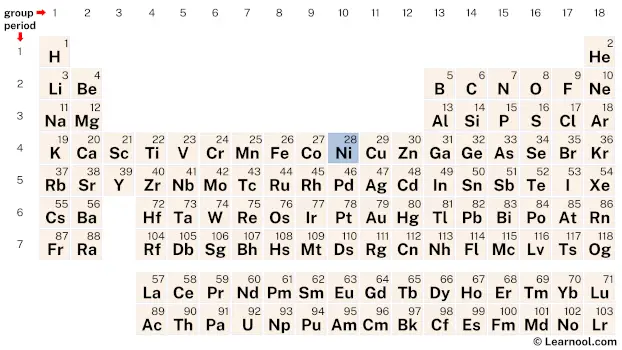
Nickel (Ni) is a chemical element of the periodic table, located in the group 10 and the period 4, and is having the atomic number 28. It is a hard, lustrous, silvery-white transition metal, whose name comes from the Saxon term “Kupfernickel”, which means devil’s copper.
On periodic table
| group | ⇨ | 1 | 2 | 3 | 4 | 5 | 6 | 7 | 8 | 9 | 10 | 11 | 12 | 13 | 14 | 15 | 16 | 17 | 18 |
| period | ⇩ | ||||||||||||||||||
| 1 | 1 H  Hydrogen |
2 He  Helium |
|||||||||||||||||
| 2 | 3 Li  Lithium |
4 Be  Beryllium |
5 B  Boron |
6 C  Carbon |
7 N  Nitrogen |
8 O  Oxygen |
9 F  Fluorine |
10 Ne  Neon |
|||||||||||
| 3 | 11 Na  Sodium |
12 Mg  Magnesium |
13 Al  Aluminium |
14 Si Silicon |
15 P  Phosphorus |
16 S  Sulfur |
17 Cl  Chlorine |
18 Ar  Argon |
|||||||||||
| 4 | 19 K  Potassium |
20 Ca  Calcium |
21 Sc  Scandium |
22 Ti  Titanium |
23 V  Vanadium |
24 Cr  Chromium |
25 Mn  Manganese |
26 Fe  Iron |
27 Co  Cobalt |
28 Ni Nickel |
29 Cu  Copper |
30 Zn  Zinc |
31 Ga  Gallium |
32 Ge  Germanium |
33 As  Arsenic |
34 Se  Selenium |
35 Br  Bromine |
36 Kr  Krypton |
|
| 5 | 37 Rb  Rubidium |
38 Sr  Strontium |
39 Y  Yttrium |
40 Zr  Zirconium |
41 Nb  Niobium |
42 Mo  Molybdenum |
43 Tc  Technetium |
44 Ru  Ruthenium |
45 Rh  Rhodium |
46 Pd  Palladium |
47 Ag  Silver |
48 Cd  Cadmium |
49 In  Indium |
50 Sn  Tin |
51 Sb  Antimony |
52 Te  Tellurium |
53 I  Iodine |
54 Xe  Xenon |
|
| 6 | 55 Cs  Caesium |
56 Ba  Barium |
72 Hf  Hafnium |
73 Ta  Tantalum |
74 W  Tungsten |
75 Re  Rhenium |
76 Os  Osmium |
77 Ir  Iridium |
78 Pt  Platinum |
79 Au  Gold |
80 Hg  Mercury |
81 Tl  Thallium |
82 Pb  Lead |
83 Bi  Bismuth |
84 Po  Polonium |
85 At  Astatine |
86 Rn  Radon |
||
| 7 | 87 Fr  Francium |
88 Ra  Radium |
104 Rf  Rutherfordium |
105 Db  Dubnium |
106 Sg  Seaborgium |
107 Bh  Bohrium |
108 Hs  Hassium |
109 Mt  Meitnerium |
110 Ds  Darmstadtium |
111 Rg  Roentgenium |
112 Cn  Copernicium |
113 Nh  Nihonium |
114 Fl  Flerovium |
115 Mc  Moscovium |
116 Lv  Livermorium |
117 Ts  Tennessine |
118 Og  Oganesson |
||
| 57 La  Lanthanum |
58 Ce  Cerium |
59 Pr  Praseodymium |
60 Nd  Neodymium |
61 Pm  Promethium |
62 Sm  Samarium |
63 Eu  Europium |
64 Gd  Gadolinium |
65 Tb  Terbium |
66 Dy  Dysprosium |
67 Ho  Holmium |
68 Er  Erbium |
69 Tm  Thulium |
70 Yb  Ytterbium |
71 Lu  Lutetium |
|||||
| 89 Ac  Actinium |
90 Th  Thorium |
91 Pa  Protactinium |
92 U  Uranium |
93 Np  Neptunium |
94 Pu  Plutonium |
95 Am  Americium |
96 Cm  Curium |
97 Bk  Berkelium |
98 Cf  Californium |
99 Es  Einsteinium |
100 Fm  Fermium |
101 Md  Mendelevium |
102 No  Nobelium |
103 Lr  Lawrencium |
|||||
| – d block |
Nickel is a d-block element, situated in the tenth column of the periodic table, between cobalt (Co) and copper (Cu). It has the atomic number 28 and is denoted by the symbol Ni.
Element information
 |
|
 |
|
| Origin of name | Saxon term “Kupfernickel” (which means devil’s copper) |
| Symbol | Ni |
| Atomic number (Z) | 28 |
| Atomic mass | 58.6934 u |
| Block | d-block |
| Group | 10 |
| Period | 4 |
| Classification | Transition metal |
| Atomic radius | 124 pm |
| Covalent radius | 124 pm |
| Van der Waals radius | 163 pm |
| Melting point | 1455 ℃, 2651 ℉, 1728 K |
| Boiling point | 2730 ℃, 4946 ℉, 3003 K |
| Electron configuration | [Ar] 3d8 4s2 |
| Electrons per shell | 2, 8, 16, 2 |
| Learn how to draw: Nickel Bohr model | |
| Crystal structure | Face-centered cubic (fcc) |
| Phase at r.t | Solid |
| Density near r.t | 8.908 g/cm3 |
| Main isotopes | Nickel-58, Nickel-60, Nickel-61, Nickel-62, Nickel-64 |
| Natural occurrence | Primordial |
| Oxidation state | +2 |
| Electronegativity (Pauling scale) | 1.91 |
| Protons Neutrons Electrons |
28 31 28 |
| Learn how to find: Nickel protons neutrons electrons | |
| CAS number | 7440-02-0 |
| Discovered by | Axel Fredrik Cronstedt in 1751 |
History

Nickel was first discovered in 1751 by the Swedish chemist Axel Fredrik Cronstedt. Cronstedt was examining a mineral called niccolite when he noticed that it produced a green color when heated with charcoal.
This led him to believe that the mineral contained a new element, which he named nickel after the German word “kupfernickel,” meaning “devil’s copper.” The metal was isolated in its pure form for the first time in 1754 by another Swedish chemist, Baron Axel Frederik Cronstedt.
Nickel was initially thought to be a form of copper, but its unique properties were soon recognized. The metal’s resistance to corrosion and its ability to withstand high temperatures made it a valuable material for use in various industries. The use of nickel for coins dates back to the mid-19th century, when it was first used as a substitute for silver in the United States.
Occurrence and production
Nickel is one of the most abundant elements in the Earth’s crust, with an estimated concentration of 80 parts per million. It is found in many minerals, including pentlandite, garnierite, and pyrrhotite. The largest deposits of nickel are located in Canada, Russia, Australia, and Indonesia.
Nickel is primarily produced from two types of ores: sulfide ores and laterite ores. Sulfide ores are processed through a conventional smelting process, while laterite ores are processed through a hydrometallurgical process. The production of nickel is a complex process that involves multiple stages, including mining, crushing, grinding, flotation, and smelting or refining.
The demand for nickel has increased over the years due to its various industrial applications, and efforts are being made to explore new deposits of the element in different parts of the world.
Properties
Nickel has a relatively high density of 8.9 g/cm³.
It is a good conductor of electricity and heat.
Nickel has a high melting point of 1455 ℃ and a boiling point of 2732 ℃.
It has the ability to alloy with other metals, forming strong and durable materials such as stainless steel.
Nickel is a hard, silvery-white metal that is highly resistant to corrosion and oxidation.
It is malleable and ductile, and can be easily shaped into various forms.
Nickel is highly reactive with oxygen and can form various compounds such as nickel oxide, nickel hydroxide, and nickel carbonate.
It is magnetic at room temperature and has a face-centered cubic crystal structure.
Nickel is also known for its catalytic properties and is used in various chemical reactions.
Applications
Nickel is extensively used in the production of stainless steel, which is a highly durable, corrosion-resistant material used in a wide range of applications such as architecture, construction, and transportation industries.
It is used as a coating or plating material for various objects to provide a shiny, decorative surface and to protect them from corrosion.
Nickel-based alloys are used in the manufacturing of gas turbines, jet engines, and other high-temperature applications because of their high strength, corrosion resistance, and thermal stability.
The metal is also used in the production of rechargeable batteries, such as nickel-cadmium and nickel-metal hydride batteries.
Nickel is added to certain types of glass to make it highly reflective, such as in the production of mirrors.
It is also used in the production of coins, such as the US five-cent coin or “nickel.”
Interesting facts
Nickel is the fifth most common element on Earth, and it is found in the Earth’s crust and core, as well as in meteorites.
The name “nickel” comes from a German word meaning “Old Nick”, which was a term used for the devil by miners who struggled to extract the metal from its ores.
Nickel has magnetic properties, which make it useful in alloys such as permalloy and in electrical applications.
Nickel is a key component in the production of stainless steel and other alloys used in the chemical and aerospace industries.
One of the most well-known uses of nickel is in the production of coins, including the United States’ “nickel” which is actually 75% copper and 25% nickel.
Nickel is also used in batteries, including rechargeable batteries used in electronic devices like cell phones and laptops.
In addition to its use in industry and technology, nickel has also been used throughout history for decorative purposes, such as in jewelry and ornamental objects.
Some people are allergic to nickel and can develop skin rashes or other reactions when exposed to it, which has led to efforts to reduce its use in everyday products like jewelry.
Related
More elements
External links
- https://www.rsc.org/periodic-table/element/28/nickel
- https://en.wikipedia.org/wiki/Nickel
- https://www.britannica.com/science/nickel-chemical-element
- https://www.livescience.com/29327-nickel.html
- https://www.ducksters.com/science/chemistry/nickel.php
- https://pubchem.ncbi.nlm.nih.gov/element/Nickel
- https://www.thoughtco.com/interesting-nickel-element-facts-3858573
- https://chemistrytalk.org/nickel-element/
- https://www.chemicool.com/elements/nickel.html
Deep
Learnool.com was founded by Deep Rana, who is a mechanical engineer by profession and a blogger by passion. He has a good conceptual knowledge on different educational topics and he provides the same on this website. He loves to learn something new everyday and believes that the best utilization of free time is developing a new skill.
